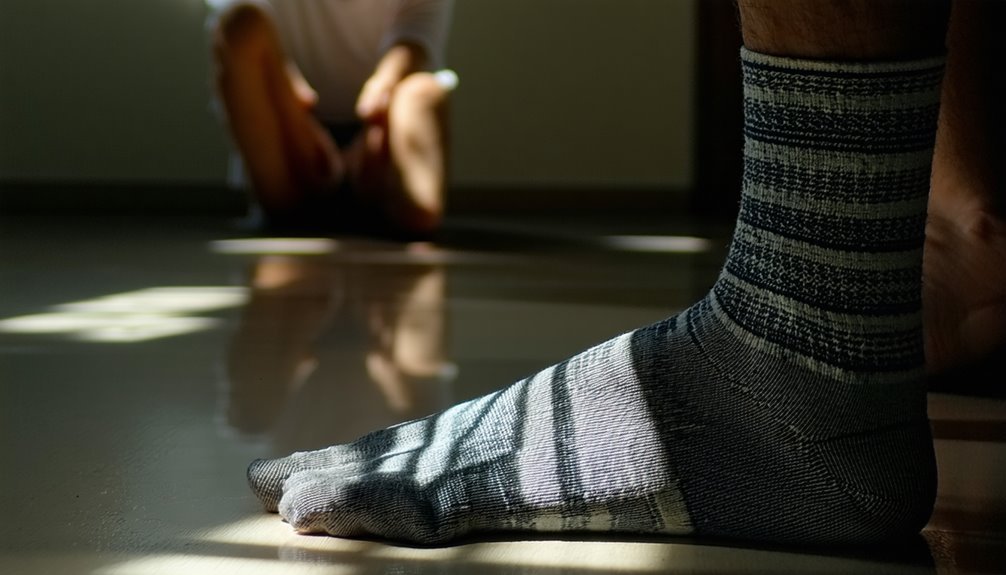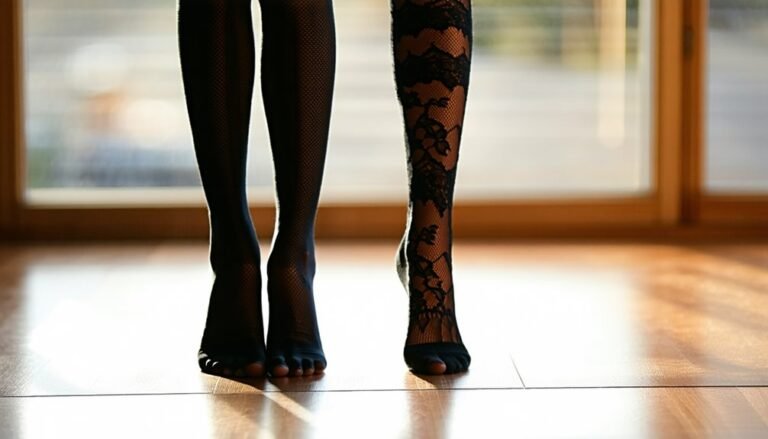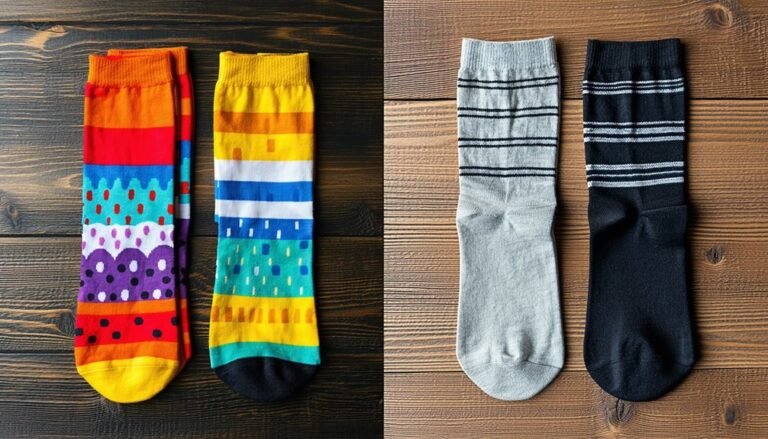Can Compression Socks Be Dangerous?
Compression socks can be beneficial, but they also pose risks if not used appropriately. Ill-fitting socks might restrict circulation, causing numbness, tingling, or discomfort. Skin irritation can occur, especially for those with allergies. It's essential to make sure they fit well and to avoid wearing them too long, particularly if you're managing conditions like peripheral arterial disease. Consulting a healthcare provider is wise. Learn about ensuring safe, effective use and avoid potential complications.
Understanding the Basics of Compression Socks

When it comes to understanding the basics of compression socks, it is vital to recognize their role in promoting vascular health and alleviating foot discomfort. You'll find that compression sock types vary in their level of pressure, designed to support different needs. Graduated compression socks are tighter at the ankle and gradually loosen up the leg, enhancing blood flow. Compression sock materials also matter; they're often crafted from a blend of nylon, spandex, or polyester to guarantee flexibility and durability. Selecting the right material is essential for comfort and effectiveness. As you explore these options, prioritize a fit that's snug yet comfortable, confirming the socks support your vascular health without compromising safety or causing unnecessary pressure on your feet.
Common Uses and Benefits of Compression Socks
Selecting the right compression socks is just the start; understanding their common uses and benefits can greatly enhance your foot health and overall well-being. These socks are more than just a fashion statement. They're designed to support various needs, from managing medical conditions to boosting athletic performance. If you're dealing with swelling or varicose veins, compression socks can aid in improving circulation and reducing discomfort. For athletes, they help enhance performance by promoting better oxygen flow and muscle recovery. Consider these benefits:
- Medical conditions: Alleviate symptoms of chronic venous insufficiency.
- Athletic performance: Improve endurance and recovery.
- General well-being: Reduce fatigue from prolonged standing or sitting.
Using compression socks wisely can lead to significant health improvements, ensuring your safety and comfort.
Potential Risks of Wearing Compression Socks
When considering compression socks, it's important to be aware of potential skin irritation, especially if you have sensitive skin or allergies. You should also guarantee the socks fit properly to avoid any restriction of circulation, which can lead to discomfort or more serious issues. By being informed about these risks, you can make the best decisions for your foot health.
Skin Irritation Concerns
Though compression socks offer numerous benefits, it is important to be aware of potential skin irritation concerns that may arise. Wearing these socks can sometimes lead to issues affecting the health of your feet. One concern is the development of a skin rash, which can occur if the socks are too tight or worn for extended periods. Additionally, some individuals may experience allergic reactions to the materials used in the socks. To minimize these risks, consider the following:
- Choose socks made from hypoallergenic materials: This can reduce the chance of allergic reactions.
- Ensure proper fit: Ill-fitting socks may cause friction and irritation.
- Monitor skin regularly: Check for signs of rash or irritation.
Circulation Restriction Issues
How do compression socks affect your circulation? When worn correctly, they can enhance blood flow in your legs by applying gentle pressure. However, if not fitted properly, they might cause circulation issues. Socks that are too tight can restrict blood flow, leading to discomfort or even more serious complications like numbness or skin discoloration.
It's essential to guarantee the right fit for your foot health, as overly snug socks can do more harm than good. Pay attention to any tingling or persistent swelling, which could indicate a problem. Consult with a healthcare professional to determine the appropriate compression level for you. Prioritize your safety by being vigilant about any signs of restricted circulation, ensuring your socks support, rather than hinder, your vascular health.
Signs You Might Be Wearing the Wrong Compression Socks
If your compression socks aren't fitting right, your feet may alert you through discomfort or other warning signs. Paying attention to these signs of discomfort can safeguard your foot health. Incorrect sizing can lead to several issues:
- Tingling or numbness: Your socks might be too tight, restricting blood flow.
- Indentations on your skin: These could indicate excessive pressure from tight socks.
- Swelling above or below the socks: This may suggest the socks are cutting in and causing fluid build-up.
It's essential that your compression socks provide the right amount of snugness without causing pain. If you experience any of these symptoms, it may be time to reassess the fit. Consult with a healthcare professional to confirm that your socks are the correct size and providing the intended benefits.
When to Avoid Using Compression Socks

While compression socks can be beneficial for many, there are specific situations when you should avoid using them. If you have certain medical conditions contraindications, such as peripheral arterial disease, congestive heart failure, or skin infections, wearing compression socks might do more harm than good. These conditions can lead to restricted blood flow, and adding compression could exacerbate the issue. Always consult your healthcare provider before use, especially if you're unsure about your health status. In some cases, compression sock alternatives might be more appropriate, such as gentle leg elevation or regular foot exercises, which promote circulation without added pressure. Your safety is paramount, and making informed decisions guarantees that you're prioritizing your foot health above all else.
The Importance of Proper Fit and Sizing
Guaranteeing a proper fit and sizing for compression socks is vital to maximizing their therapeutic benefits while minimizing potential risks. Ill-fitting socks can lead to discomfort, impaired circulation, and even skin damage. To guarantee safety and effectiveness, follow these fitting guidelines closely.
Ensure proper fit for compression socks to maximize benefits and minimize risks like discomfort and impaired circulation.
- Sock Measurements: Measure your ankle, calf, and possibly thigh circumference. Don't skip this step—accurate measurements are essential.
- Consider Length: Choose between knee-high or thigh-high based on your specific needs and comfort.
- Check Compression Level: Consult with a healthcare provider to select the appropriate level of compression tailored to your condition.
How Long Should You Wear Compression Socks?
Understanding how long to wear compression socks is essential for maximizing their benefits and avoiding potential complications. Typically, wearing them during the day and removing them at night is recommended, but your specific needs might vary based on your health condition and doctor's advice. Overuse can lead to skin irritation or impaired circulation, so it's important to follow guidance tailored to your individual situation.
Optimal Wear Duration
When determining the ideal duration for wearing compression socks, it is essential to take into account both your medical needs and lifestyle. Tailoring suitable wear strategies guarantees you gain maximum benefits while maintaining safety. Generally, daily wear guidelines suggest wearing them during waking hours and removing them before bed. However, this might vary based on individual needs.
Consider these factors:
- Medical Conditions: Conditions like varicose veins or post-surgery recovery might require longer wear.
- Activity Level: If you're on your feet all day, extended wear could be beneficial.
- Comfort and Fit: Make sure they're snug but not too tight, preventing discomfort or circulation issues.
Consulting with a healthcare provider will provide personalized advice, aligning wear duration with your specific health requirements.
Risks of Overuse
While compression socks offer numerous benefits for foot health, wearing them too long can lead to complications. Overuse symptoms like skin irritation, numbness, or tingling may arise, signaling the need for caution. Prolonged wear can also cause long-term effects, such as impaired circulation or dependency on the socks for comfort. To guarantee safety, it's essential to monitor the duration of wear and watch for any signs of discomfort or adverse reactions. Here's a quick guide to help you manage usage effectively:
| Duration of Wear | Overuse Symptoms | Long-Term Effects |
|---|---|---|
| Less than 8 hours | Minimal risks | Rare |
| 8-12 hours | Possible skin irritation | Unlikely |
| Over 12 hours | Numbness or tingling | Impaired circulation |
| Overnight | Increased discomfort | Dependency potential |
Consider consulting a healthcare professional for personalized advice.
Who Should Consult a Doctor Before Using Compression Socks?
Have you ever wondered if you should consult a doctor before slipping on compression socks? It's vital to take into account your medical history and any underlying conditions. Seeking medical advice guarantees safety and effectiveness, especially if you have specific health concerns. You should talk to your doctor if you have:
- Peripheral arterial disease: Compression can worsen symptoms if blood flow is already compromised.
- Diabetes: This condition can affect sensation in your feet, making it necessary to get tailored advice.
- Skin infections or wounds: Compression might aggravate these, leading to further complications.
Your physician understands your unique medical background and can provide guidance on whether compression socks are a safe option. Prioritizing consultation is a step towards safe, effective foot care.
Tips for Safe and Effective Use of Compression Socks

Although compression socks can be a beneficial tool for improving circulation and reducing discomfort, using them safely and effectively requires some guidance. Following compression sock guidelines is vital to maximize their benefits. Start by choosing the right level of compression—generally measured in mmHg—based on your specific needs. It's important to confirm a proper fit; socks that are too tight may cause constriction, while loose ones won't be effective.
User experience tips include gradually increasing wear time to allow your feet to adjust. Always put them on in the morning, as swelling is typically less, and remove them before bed. Regularly inspect your skin for any signs of irritation or pressure marks. Prioritize comfort and consult a healthcare professional for personalized advice.
Frequently Asked Questions
Can Compression Socks Cause Skin Irritation or Allergies?
If you've got a touch of skin sensitivity, compression socks might occasionally give your feet a little unfriendly nudge. Some folks experience mild allergic reactions. Always choose socks with hypoallergenic materials and consult a foot specialist for guidance.
Is It Safe to Wear Compression Socks While Sleeping?
You're wondering about sleeping safely with compression socks. While benefits are discussed, like improved circulation, it's essential to consult a doctor first. They'll guarantee they're suitable for you, preventing issues like reduced blood flow or skin irritation.
Can Compression Socks Affect Circulation in Healthy Individuals?
Think of compression socks as a gentle hug for your legs. For healthy individuals, proper compression levels maintain healthy circulation. However, incorrect levels might squeeze too tightly, potentially hindering circulation. Always consult a specialist for personalized advice.
How Often Should Compression Socks Be Washed?
You should wash compression socks after each use to maintain hygiene and elasticity. The washing frequency depends on fabric choice; delicate materials might need gentler care. Prioritize your foot health by following care instructions for maximum safety and comfort.
Are There Alternatives to Compression Socks for Similar Benefits?
Think of your legs as a tree needing support. Alternatives like compression wraps provide stability, while leg elevation boosts circulation. They're safe, effective options ensuring your veins remain healthy, promoting comfort and reducing risks without wearing socks.







